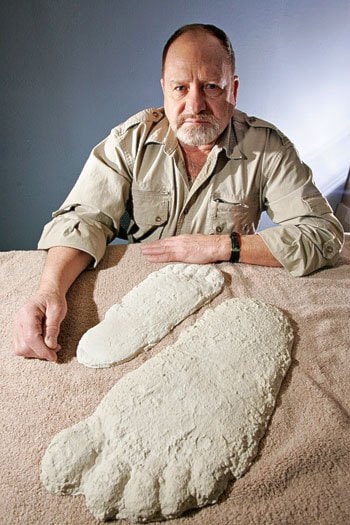If you phone Environment Yukon and ask about sasquatch numbers in the territory, you’ll most likely receive a silent moment of apprehension and bewilderment, as if the person on the other end is deciding whether it’s a crank call.
However, others are less skeptical on the topic of cryptozology, and are instead believers of the existence of sasquatch.
And they are searching for them too.
Not only is there a Canadian Sasquatch Research Organization (CSRO), some might be surprised to learn that its president, Red Grossinger, lives right here in Whitehorse.
“We are a bunch of people with different backgrounds with an interest in sasquatch and what we would like to do is prove its existence,” said Grossinger. “Of course, that’s pretty hard to do. The only proof you can get is a body; that is the only proof acceptable by the scientific community.”
A retired Canadian Army officer, Armoured Corps, Grossinger, 67, moved to Whitehorse in 1987 and acquired an interest in sasquatch in 2003 after experiencing unexplainable occurrences he was later told fit the description of sasquatch activities.
“At Frenchman Lake, I had an odor experience,” said Grossinger, who admits to never having seen a sasquatch. “There were two of us fishing and we came across this smell that lasted probably 45 seconds to a minute. It was an extremely strong smell, not of an animal - I know that as a fact (because) I’m a hunter. It smelt like baby diapers mixed with dog excrement with a bit of a smell of sulphur on top of that.
“We came upon this smell and, prior to that, all the birds stopped singing; for whatever reason, there was no chirping of birds or movement in the bush. It was dead quiet.
“We looked around and there was nothing around. And within a couple minutes the forest was active again.”
The CSRO, formally the Western Canadian Sasquatch Research Organization, is based in Calgary with branches in BC, NWT, Saskatchewan, Ontario and the Yukon.
The CSRO has records of 81 reports of sasquatch phenomena in the Yukon dating back to 1871, including actual sightings, the discovery of tracks, loud screaming or noises, unusual odours, traces of fur and other, less common clues of sasquatch activity.
Grossinger alone has investigated 24 reports of sasquatch evidence in Yukon and Northern BC.
“Actually Whitehorse is a hot spot; right around Whitehorse there’s a lot,” said Grossinger.
Unfortunately for Grossinger and the CSRO, things have been quiet recently.
“Nothing in 2009 - not a thing,” said Grossinger. “Actually there was hardly anything across Canada. There was one sighting on Vancouver Island, but that’s all that’s been reported this year.”
The most recent sasquatch report in the Yukon came out of Keno in the summer of 2008, with a visitor to the territory claiming visual contact with a male and pregnant female.
“The person that saw them was conducting hearing tests at different minesites - he has a mobile hearing test outfit to see if people there need new ear protection,” said Grossinger, who is restricted from releasing names of witnesses.
“He’s the type of person who is serious in his type of business and was not someone who would claim something that was not true.”
Just a few months earlier a married couple, fishing at Simpson Lake, reported hearing loud “whooping” sounds from the wilderness. As the couple approached the lake, “They heard these vocal (sounds),” said Grossinger. “She said it was sounds like she never heard before.
“She said it was extremely loud - it scared the shit right out of them!”
There have also been sightings near Fox Lake in 2007, on the South Klondike Highway in 2006 and numerous others in and around Teslin between 2004 and 2006.
But the CSRO looks into more than actual sightings or “Class A” encounters, giving time to “Class B” encounters such as hair found in the wilderness of dubious origin.
In 2006 and 2007, four different hair samples suspected of being from a sasquatch from within the Yukon were given to Grossinger, who then had them analyzed at a lab in Calgary.
“The guy at the lab confirmed one is human hair, the other three, he doesn’t know,” said Grossinger. “There was nothing at all to connect them to any known animal.”
To help the CSRO establish protocol and procedures for investigations, Grossinger is currently putting the finishing touches on a field guide titled the Sasquatch Field Research Handbook. He is also working on a Sasquatch Research Training Program to be taught in the Yukon, starting next year, followed by research videos in 2011.
These initiatives are intended to help the CSRO fulfill its mission, which is “to conduct ethical research and field investigations, by using standardized procedures and protocols, which will result in the CSRO proving the actual existence of the homonid sasquatch,” says the organization’s website.
Grossinger knows the scientific community has very stringent precepts separating proof from evidence, so he thinks the sasquatch debate will perhaps continue until some marvelous stroke of luck delivers the necessary proof to quash the cries of skeptics.
“The best thing that could happen is someone finds one that was hit by a truck,” said Grossinger. “They’ve tried cages in the states, but none have walked into any yet.
“Killing is out of the question, that’s for sure.”
To report any sasquatch encounters, learn more about the organization or join, visit www.csro.ca.
Contact Tom Patrick at
tomp@yukon-news.com
